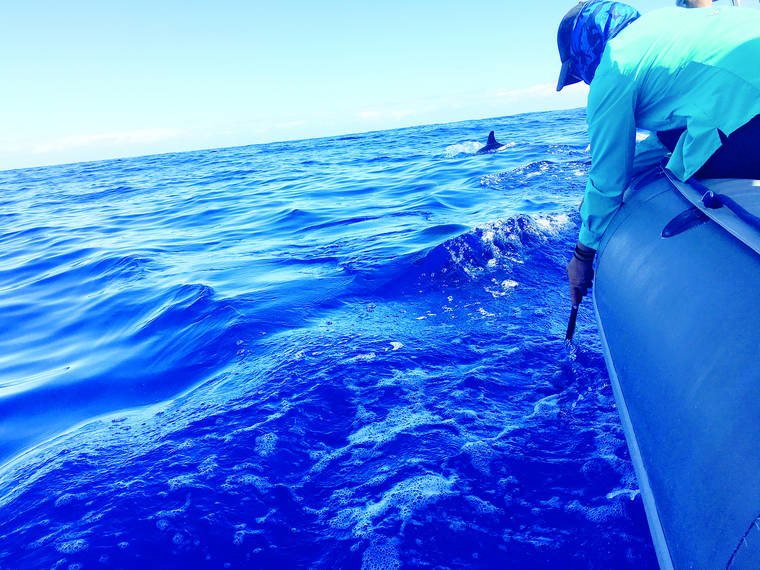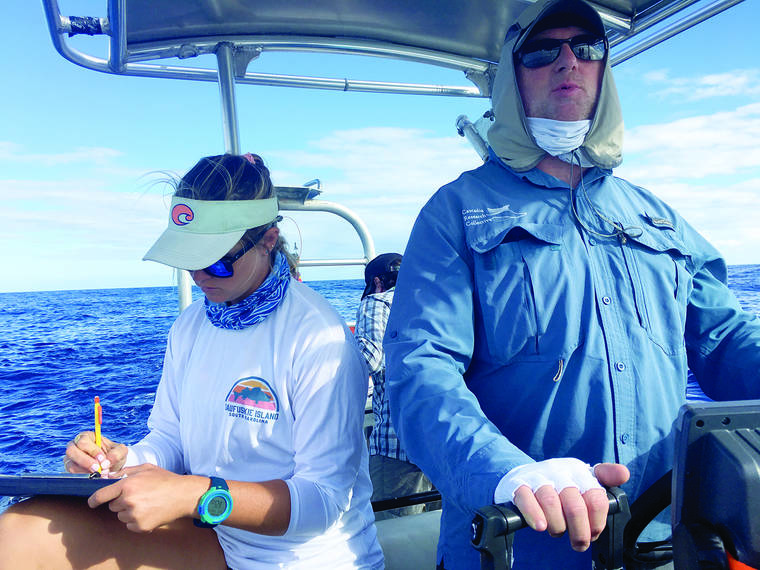MAJORS BAY — Scientists studying sonar’s effect on marine mammals near the U.S. Navy’s Pacific Missile Range Facility at Barking Sands have released another report in an ongoing study for the Navy’s U.S. Pacific Fleet, and it’s showing the same kind of mixed results they’ve been documenting since 2011.
For two years, researchers documented behavior patterns of marine mammals in relation to mid-frequency active sonar, and they found some animals moved away from the noises. Others moved closer.
That means the Navy won’t be making any changes, based on the report, as to how they interact with whales, dolphins and other marine species.
The Navy follows a list of laws and protective measures, and has set aside mitigation areas that are aimed at protecting those animals from sonar and other Navy activities.
Studies commissioned by the Pacific Fleet, meanwhile, have been gathering data on different species’ reaction to their activities, with reports issued every few years.
The Pacific Fleet says the project proves the Navy’s commitment to their environmental stewardship responsibilities.
“This report is the most recent example of the Navy’s ongoing commitment to support the research needed to improve our understanding of how marine mammals may respond to the acoustic sources used during authorized Navy training activities,” the Pacific Fleet said in a statement to The Garden Island.
While consistent results didn’t surface in this latest report, done by the nonprofit research and education organization Cascadia Research Collective and under the direction of researcher Robin Baird, scientists did document behavior changes during the study.
For example, they detail the activity of two individual rough-toothed dolphins in their report’s executive summary: “Nighttime dive depths and durations did differ significantly among the three sonar-exposure periods for both individuals, but not in a consistent way, suggesting that some factor other than MFAS (mid-frequency active sonar) exposure may have been influencing the diving behavior of one or both individuals,” the report says.
Researchers specifically studied species of resident and non-resident odontocetes (toothed whales) in the Kaulakahi Channel, the channel between Kauai and Niihau. PMRF uses an area of those waters for submarine command courses and other training.
That’s the perfect opportunity to study whether any “large-scale movements” happen in response to hull-mounted surface ship MFAS exposure, scientists say.
They use satellite tagging to monitor animal behavior, tagging which started in 2011 and has gotten more precise with the evolution of technology.
This report included a few key improvements to data collection that helped provide a clearer picture for scientists, and that process will continue as technology continues to evolve and the study progresses.
“The study is ongoing and another field season has been planned for February 2020. In addition to collecting more data, new analysis techniques have recently been developed,” the Pacific Fleet statement said.
“These new techniques will be used to reanalyze this historical as well as new data in order to examine how marine mammals may respond to sonar,” said the statement.
As with previous versions of this report, the study will be added to the Navy’s body of best-available science, and goes over to the National Marine Fisheries Service as well, helping both entities finalize rules and practices when it comes to marine-mammal protection.
•••
Jessica Else, environment reporter, can be reached at 245-0452 or jelse@thegardenisland.com.







One question is whether or not the Navy contracted the same non profit, Cascadia and lead scientist Robin Baird, for the again inconclusive tests done in 2011 as well. If they get the same inconsistent results then more than one research group should be deployed in the next go around in 2020. Maybe U OF H and FIU and FSU should be brought in too. Also the test bed should, at the very least, be looked at. By their peers to get a consensus and zero in on why the overall test results have been non- conclusive. Too conclude that the amount of noise and it’s effects on Cetacean’s is questionable quite frankly is ridiculous. The Navy should watch the film Sonic Seas and get a clue. There research funds are impressive, their results and RESOLUTION are not.